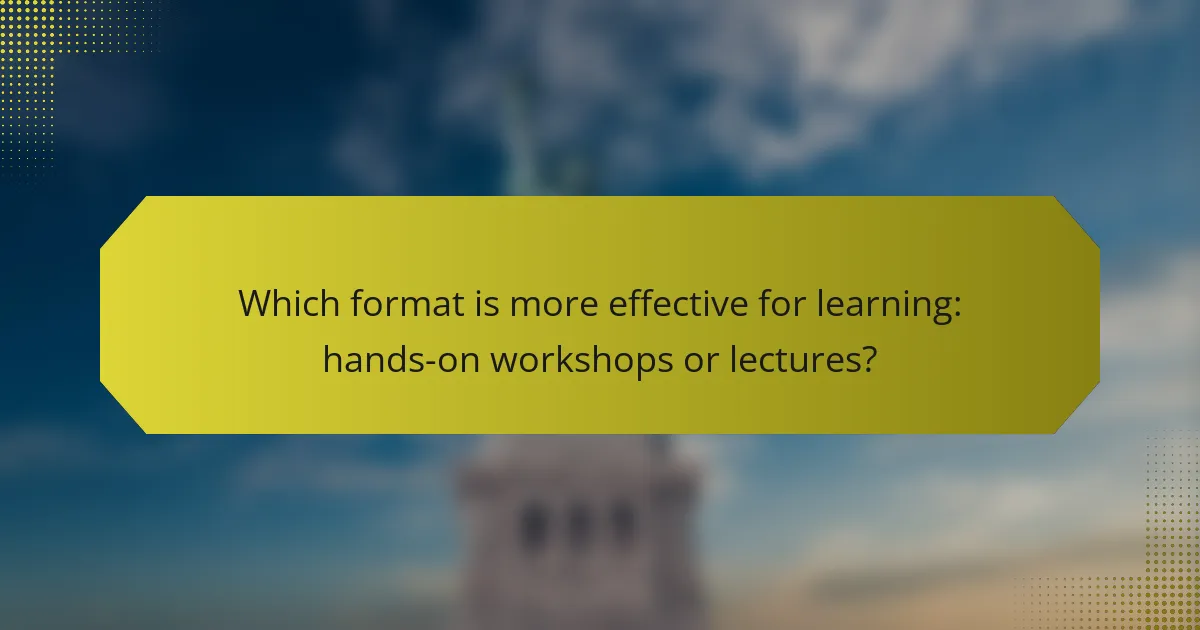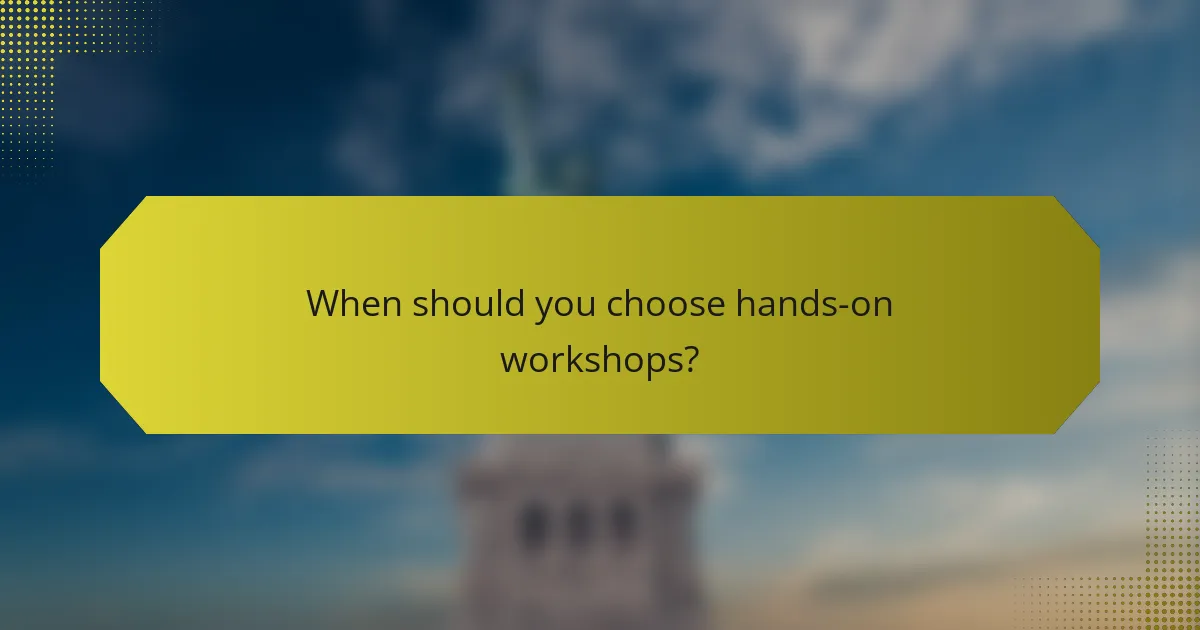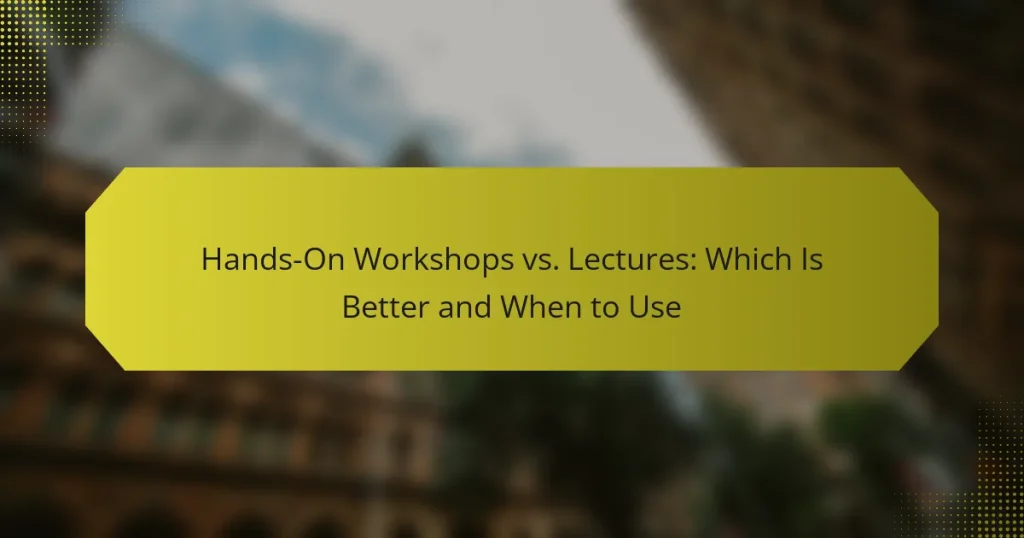When deciding between hands-on workshops and lectures, it’s essential to consider the learning objectives and context. Hands-on workshops promote active engagement and practical application, making them ideal for skill acquisition, while lectures efficiently convey theoretical concepts to larger audiences. Understanding when to use each method can significantly enhance the learning experience.

Which format is more effective for learning: hands-on workshops or lectures?
Hands-on workshops are generally more effective for learning because they encourage active participation and practical application of knowledge. Lectures, while informative, often lack the interactive elements that help reinforce learning through experience.
Hands-on workshops promote active engagement
Hands-on workshops foster a learning environment where participants actively engage with the material. This format allows learners to practice skills in real-time, which can lead to better retention and understanding. For example, in a coding workshop, attendees can write and debug code, reinforcing concepts through direct application.
Additionally, workshops often encourage collaboration among participants, enhancing the learning experience. Group activities and discussions can lead to diverse perspectives and problem-solving approaches, making the learning process more dynamic and effective.
Lectures provide structured information delivery
Lectures are effective for delivering structured information to a large audience in a concise manner. They allow instructors to cover a wide range of topics and present foundational knowledge efficiently. For instance, a lecture on economic principles can introduce key concepts and theories that learners can later explore in-depth through other formats.
However, the challenge with lectures is that they may not engage all learners equally. Some individuals may struggle to retain information presented in a passive format. To enhance retention, it can be beneficial to incorporate interactive elements, such as Q&A sessions or brief discussions, within the lecture structure.

When should you choose hands-on workshops?
Hands-on workshops are ideal when practical experience and active participation are crucial for learning. They allow participants to engage directly with the material, making them particularly effective for skill acquisition and real-world applications.
For skill-based training and practical applications
Hands-on workshops excel in environments where skill-based training is necessary. For instance, fields like cooking, carpentry, or software development benefit greatly from this approach, as participants can practice techniques and receive guidance in real-time.
Consider using hands-on workshops when you need to teach complex tasks that require practice to master. This method allows learners to experiment, make mistakes, and refine their skills under the supervision of an instructor.
When immediate feedback is essential
Immediate feedback is a significant advantage of hands-on workshops. Participants can receive instant corrections and suggestions, which enhances their understanding and retention of the material. This is particularly beneficial in technical fields or creative disciplines where adjustments can lead to better outcomes.
For example, in a workshop focused on graphic design, participants can create projects and receive real-time critiques, enabling them to improve their work on the spot. Ensure that the workshop environment encourages open communication, allowing learners to ask questions and clarify doubts as they practice.

When are lectures the better option?
Lectures are often the better option when the goal is to convey theoretical concepts or provide a broad overview to a large audience. They allow for efficient dissemination of information, especially when detailed interaction is not feasible.
For theoretical concepts and broad overviews
Lectures excel in presenting theoretical concepts and broad overviews because they can cover a wide range of material in a structured format. This is particularly useful in academic settings, where foundational knowledge is essential for understanding more complex topics later on.
For example, a lecture on the principles of economics can introduce key theories and models to students, laying the groundwork for more specialized courses. This approach helps ensure that all participants receive the same foundational information, which is crucial for subsequent discussions or workshops.
When large audiences are involved
Lectures are ideal for large audiences, as they enable a single speaker to reach many individuals simultaneously. This format is often used in universities, conferences, and corporate training sessions where attendance can range from dozens to thousands.
When planning a lecture for a large group, consider using visual aids, such as slides or videos, to enhance engagement and retention. Additionally, providing handouts or digital resources can help attendees follow along and reference key points later, ensuring that the information is accessible even after the session concludes.

What are the costs associated with each format?
The costs associated with hands-on workshops and lectures can vary significantly based on several factors, including venue, materials, and instructor fees. Generally, workshops tend to be more expensive due to their resource-intensive nature, while lectures usually incur lower overhead costs.
Hands-on workshops often require more resources
Hands-on workshops typically necessitate a variety of resources, including specialized equipment, materials, and facilities. For instance, if a workshop involves practical exercises, costs can include tools, supplies, and space rental, which can add up to hundreds or even thousands of dollars depending on the scale.
Additionally, instructors for workshops often demand higher fees due to the interactive nature of the sessions and the preparation required. It’s essential to budget for these expenses when planning a workshop to ensure a successful experience.
Lectures typically have lower overhead costs
Lectures usually have lower overhead costs because they require fewer resources. A lecture can often be conducted in a standard classroom or auditorium, minimizing venue expenses. The primary costs involved are typically the speaker’s fee and any necessary materials, such as handouts or presentation equipment.
In many cases, lectures can accommodate larger audiences, allowing the costs to be spread across more participants, which can make them a more economical choice for educational institutions or organizations. This scalability is a significant advantage when considering budget constraints.

How do participant engagement levels compare?
Participant engagement levels differ significantly between hands-on workshops and lectures. Workshops typically encourage active participation, while lectures often result in more passive learning experiences.
Hands-on workshops foster higher interaction
Hands-on workshops are designed to promote active involvement, allowing participants to engage directly with the material. This format encourages collaboration, problem-solving, and immediate feedback, which can enhance understanding and retention of information.
For example, in a workshop setting, participants might work in small groups to tackle real-world scenarios, facilitating discussions and shared learning experiences. This interactive approach often leads to higher satisfaction and a deeper grasp of the subject matter.
Lectures may lead to passive learning
Lectures, while efficient for delivering information to large groups, often result in passive learning. Participants typically listen and take notes without engaging in discussions or hands-on activities, which can limit their ability to retain and apply knowledge.
In a lecture format, the instructor presents information in a one-way communication style, which may leave participants feeling disconnected. To mitigate this, incorporating brief Q&A sessions or interactive polls can help maintain engagement, but these strategies may still fall short compared to the dynamic nature of workshops.

What are the prerequisites for effective workshops?
Effective workshops require participants to have certain prerequisites to maximize learning and engagement. These include prior knowledge of the subject matter and access to necessary tools and materials.
Prior knowledge of the subject matter
Having a foundational understanding of the topic is crucial for participants to fully engage in a workshop. This prior knowledge allows them to grasp complex concepts more quickly and contribute meaningfully to discussions and activities.
For example, a workshop on advanced coding techniques would be less effective for beginners who lack basic programming skills. Ideally, participants should have a baseline competency that aligns with the workshop’s objectives.
Access to necessary tools and materials
Participants must have access to the tools and materials required for the workshop to ensure a hands-on experience. This includes software, hardware, or any specific resources that will be utilized during the session.
For instance, a workshop focused on graphic design should ensure that attendees have access to design software like Adobe Creative Suite and a computer capable of running it. Without these resources, the effectiveness of the workshop diminishes significantly.

What are the benefits of combining both formats?
Combining hands-on workshops and lectures enhances the overall educational experience by leveraging the strengths of each format. This approach allows for deeper understanding and retention of material, catering to a broader range of learning preferences.
Enhanced learning through varied teaching methods
Utilizing both workshops and lectures can significantly improve knowledge retention. Lectures provide foundational knowledge and theoretical context, while hands-on workshops allow participants to apply what they’ve learned in practical scenarios. This combination helps solidify concepts and encourages active engagement.
For instance, in a technology training program, a lecture might cover software features, followed by a workshop where participants practice using the software. This sequential learning reinforces understanding and builds confidence in applying new skills.
Flexibility to cater to different learning styles
Different individuals absorb information in various ways, and combining formats addresses these diverse learning styles. Some learners thrive in interactive environments, while others prefer structured, lecture-based formats. By offering both, educators can reach a wider audience effectively.
To implement this, consider alternating between lectures and workshops in your curriculum. For example, after a lecture on marketing strategies, follow up with a workshop where participants create their own marketing plans. This not only accommodates different preferences but also encourages collaboration and peer learning.


